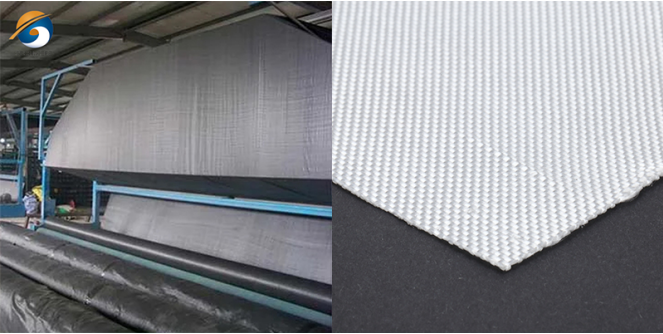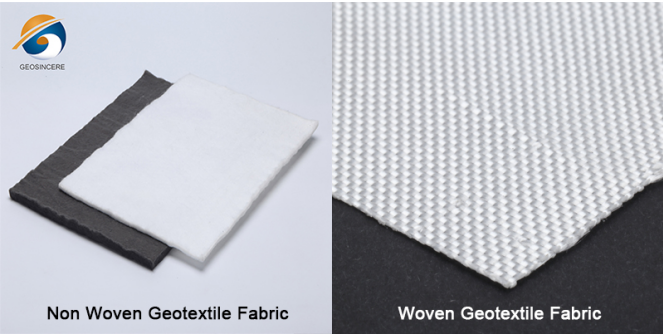What ls The Difference of Woven vs Nonwoven Geotextile Fabric?
Woven and Non-woven Geotextiles are two common geosynthetic materials used in various civil engineering and construction applications. The main difference between them lies in their manufacturing process and the resulting characteristics.Through this article, let's explore the differences between two types of geotextiles in terms of manufacturing process, fabric structure, strength and filtration, as well as applications.
1.What Are The Different Manufacturing Processes Between Woven and Non-woven Geotextiles?
1.1 The Manufacturing Process of Non woven geotextile Fabric
Non-woven geotextile fabric is a specialized material used in various civil engineering and construction applications. It is designed to provide filtration, separation, reinforcement, and drainage functions in geotechnical projects. The manufacturing process of non-woven Geotextile Fabric typically involves the following steps:
1.1.1 Raw Material:Non-woven geotextiles are commonly made from synthetic fibers such as polyester, polypropylene, or polyethylene. These fibers are produced in the form of continuous filaments or staple fibers.
1.1.2 Fiber Formation: The selected raw materials are then processed to form fibers. This can be done through various methods such as extrusion, spinning, or carding. The fibers are typically thin and continuous to ensure uniformity and strength in the final fabric.
1.1.3 Web Bonding: The fiber web is bonded together to create a stable fabric. Bonding methods include thermal bonding, chemical bonding, and needle punching.The web passes through heated rollers or ovens that melt thermoplastic fibers, causing them to fuse at contact points.Barbed needles are punched through the fiber web, entangling the fibers and creating interlocking loops that bond the fabric.
1.1.4 Finishing: The bonded non-woven geotextile fabric undergoes finishing processes to enhance its properties. These may include calendering, where the fabric passes through hot rollers to improve smoothness and uniformity, or coating, where a layer of polymer or other material is applied for specific characteristics like water resistance or UV stability.
1.1.5 Quality Control: Throughout the manufacturing process, quality control measures are implemented to ensure the fabric meets the required specifications. This involves rigorous testing for parameters such as tensile strength, tear resistance, permeability, and durability.
1.1.6 Packaging: Once the non-woven geotextile fabric passes the quality control tests, it is packaged in rolls or bales for shipment and distribution to customers.
1.2 The Manufacturing Process of Woven Geotextile Fabric

Woven geotextile fabric is crafted by interlacing individual yarns or fibers, creating a stable and uniform structure with visible pores. Its weaving process imparts high tensile strength in both longitudinal and transverse directions, making it ideal for applications that require strength and stabilization. Woven geotextiles find applications in soil reinforcement, erosion control, and road stabilization projects.
1.2.1 Raw Material:Woven geotextile fabric is crafted by interlacing individual yarns or fibers, such as polypropylene or polyester, through a weaving process. The interlacing creates a stable and uniform structure with visible pores or openings between the yarns. This woven structure imparts high tensile strength to the fabric in both the longitudinal and transverse directions.
1.2.2 Yarn Production: The fibers are spun into yarns through processes like extrusion or spinning. In extrusion, molten polymer is forced through spinnerets to form continuous filaments. Spinning involves converting staple fibers into yarns by twisting them together.
1.2.3 Weaving: The warp sheet is mounted onto a loom, and the weft yarns are interlaced with the warp yarns to create the woven structure. The weaving process determines the type of weave pattern used, such as plain weave, twill weave, or satin weave, which affects the fabric's properties.
1.2.4 Finishing: After weaving, the woven geotextile fabric undergoes finishing processes to enhance its performance. This may include treatments like heat setting to stabilize the fabric dimensions, or applying coatings or additives to improve specific characteristics like UV resistance or water repellency.
1.2.5 Roll-Up and Packaging: Once the woven geotextile fabric passes quality control, it is rolled up onto large spools or rolls and prepared for packaging.
2.What Are The Differences in Fabric Structure Between Woven and Non-woven Geotextiles?
The fabric structure of woven and nonwoven geotextiles differs due to their distinct manufacturing processes:
2.1 Woven Geotextiles:
Woven geotextiles have a distinct fabric structure characterized by interlaced individual yarns or fibers. The weaving process creates a grid-like pattern with visible, regularly spaced pores or openings between the yarns. The interlacing of the yarns forms a stable and uniform fabric structure with high tensile strength in both the longitudinal and transverse directions. The woven structure provides a clear and defined pattern with consistent pore sizes.
2.2 Nonwoven Geotextiles:
Nonwoven geotextiles have a different fabric structure compared to woven geotextiles. They are manufactured by entangling fibers together through mechanical, thermal, or chemical processes, without the need for weaving or knitting. During the manufacturing process, the fibers are randomly arranged and bonded, resulting in a more homogenous structure. Nonwoven geotextiles do not have the visible grid-like pattern or clearly defined pores found in woven geotextiles. Instead, they have a fuzzy or felt-like appearance with a random distribution of fibers.
In summary,The structural differences between woven and nonwoven geotextiles impact their performance and properties. Woven geotextiles, with their interlaced yarns and clear pore structure, offer high tensile strength, stability, and filtration capabilities. The defined pore sizes allow for controlled water flow and effective filtration of particles. Nonwoven geotextiles, on the other hand, have a random fiber arrangement that provides excellent permeability and drainage properties. Their structure allows water to flow through while retaining fine particles, making them effective for filtration and separation applications.
3.How To Choose Between Woven Geotextiles and Non-woven Geotextiles In Application?
When choosing between woven geotextiles and non-woven geotextiles for a specific application, there are several factors to consider. Here are some key points that can help you make an informed decision:
3.1 Function: Determine the primary function of the geotextile in your application.
- Woven Geotextiles: They are made by weaving together filaments or yarns, resulting in a strong and durable fabric. Woven geotextiles are typically used in applications that require high tensile strength, such as soil stabilization, erosion control, and reinforcement of embankments.
- Non-woven Geotextiles: They are manufactured by bonding or needle-punching fibers together. Non-woven geotextiles are commonly used for applications that require filtration, separation, and drainage, such as road construction, subsurface drainage, and landscaping projects.
3.2 Filtration and Drainage: Consider the need for filtration and drainage in your application.
- Woven Geotextiles: Due to their inherent permeability, woven geotextiles provide limited filtration and drainage capabilities.
- Non-woven Geotextiles: Non-woven geotextiles have a random fiber arrangement, which provides excellent filtration and drainage properties. They allow water to pass through while preventing the movement of soil particles, making them ideal for applications where filtration and drainage are crucial.
3.3 Strength and Stabilization: Evaluate the level of strength and soil stabilization needed in your project.
- Woven Geotextiles: Woven geotextiles offer high tensile strength and are effective in stabilizing soil, preventing erosion, and reinforcing embankments. They are commonly used in applications that require load distribution and soil stabilization.
- Non-woven Geotextiles: While non-woven geotextiles are not as strong as their woven counterparts, they still provide some level of soil stabilization. They are often used in conjunction with other materials, such as geogrids or geomembranes, to enhance their reinforcement capabilities.
In summary, in different applications, non-woven and woven geotextiles should be selected based on factors such as functionality, filtration and drainage, strength, and stability.
We offer ODM (Original Design Manufacturing), OEM (Original Equipment Manufacturing), and customization services. By offering tailored solutions, you can have confidence that the GEOSINCERE will meet your exact requirements and provide optimal performance for your specific project.







